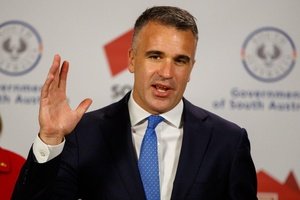“It was pretty confronting,” the human performance researcher and consultant says.
“There was this girl in [his] Kindergarten, beautiful, great little kid, well-behaved, charming, that whole bit.
“[The principal] said that one lunchtime the weather had changed, and it started raining and it got cold, and the girl’s father showed up with a jumper and a raincoat, and saw the principal and said, ‘hey, can you give this stuff to my daughter because I don’t want her to get cold and wet’.
“‘Of course’, the principal replied. It was the last encounter they were to have. The father returned home and took his own life that same afternoon.
“And he said, ‘man, there is not a day where I don’t think about that’,” Fraser says.
“There are other stories from principals of similar nature, but particularly that story really hit me hard, because I’ve got two young daughters.
“I can’t even imagine what it would be like for him.”
Spurred to investigate the impact of secondary traumatic stress on Australia educators, Fraser teamed up with Deakin University to launch a study involving 2300 school staff, including in-depth interviews with 107 participants.
The findings, released last week, are startling.
Some 39 per cent of educators reported being frequently affected by the trauma of others, while a further 38 per cent experienced it sometimes.
More than half said they experience some degree of depression due to secondary trauma in schools.
Our teachers and school leaders have become society’s social workers, Fraser says.
“When I looked at the research, there was literally nothing out there (on this), like nothing had been done in Australia. Even globally there was very little.
“There has been some research done [with] counsellors, social workers, health workers, but no one had looked at it in education.
“That’s what prompted the study, and every educator I spoke to went, ‘oh yeah, I’ve got like ten of those stories’.
“So, we just went … ‘we need to shine a light on this’.”

Dr Adam Fraser says researchers were “really stunned” to find how much our school workforce are exposed to secondary traumatic stress.
Almost 65 per cent of school staff said they were preoccupied about one or more students that they help.
Some 45 per cent said they sometimes or often feel as though they are experiencing the trauma of these children.
Fraser said that many educators thought that because they hadn’t experienced the trauma directly it ‘shouldn’t affect me that bad’.
“But with secondary trauma, one of the biggest things we discovered is just how prevalent it is, and it happens every single day in some schools.
“When most people think about trauma, they think about a big thing, like an accident or a suicide at the school, something like that.
“And what’s really concerning is, out of the comments, the top four drivers of this are domestic violence, neglect, physical assault and sexual assault [within students’ home life].”
Teachers are so often the first people children turn to in disclosing such incidents. They must also manage the emotional and psychological fall-out, Fraser adds.
“What often happens is that the student experiences a trauma, and then that dramatically affects their behaviour.
“So it’s either they disconnect, they lash out, they’re verbally abusive, they’re physically abusive.
“The educators kind of experience [the trauma] twice.”
Fraser says researchers were “really stunned” to find not only how much our school workforce are exposed to secondary traumatic stress, but also how devastating it can prove to be for individuals, with burnout and mental health risks a very real consequence.
Almost 40 per cent of participants said they were considering walking away from education. Another 18 per cent were undecided if they will stick it out due to second-hand trauma.
It’s time for policymakers to wake up to this, Fraser suggests.
“We just judge schools on their NAPLAN results and their HSC results, but they spend so much time in these other areas that we don’t measure or think are important.
“One thing that educators said is, ‘not only am I dealing with all this secondary traumatic stress, but also I’ve got a massive workload – I have to write reports, I have to do compliance, I have to hand all this stuff in. I'm drowning in work, and I have all this emotional stuff to work on’.
“The system [should be making moves to] streamline processes, to reduce the volume of reporting, to give educators more time to connect with the students and support them,” Fraser argues.
The research also found that for many educators, secondary trauma comes about because they simply cannot access services to get help for students living in abusive or neglectful environments.
They then have to send these children home each day, grappling with the knowledge that their safety and wellbeing is at risk.
“Many of them said that those [child and family support] agencies are under-resourced and understaffed, so they can spend all day on the phone trying to get someone,” Fraser warns.
“And what also occurs is, because they’re understaffed, they might describe a situation and those services go, ‘hey, that’s not bad enough for us right now’.”
School leadership have a huge role to fulfill here too, Fraser notes.
“Understanding that this is a real issue that affects people and checking in with their staff and supporting and taking care of them is a very important thing.
“What we found in our research is that having a supportive supervisor that checks in, that is empathetic, that is understanding, really helps people deal with this sort of trauma.”
More broadly, Fraser says a school culture that’s hinged on care is essential.
“It’s not just the leader that has to do this, it”s everyone.
“And one thing we did find is having supportive peers that you can turn to and talk to and go, ‘man, I found that really hard’ or, ‘that was very stressful for me’, is a critical piece.”
The study also measured educators’ ‘compassion satisfaction’ – an area that elicited some insightful results.
“That means when I help someone, does that give me a good feeling? And do I feel like I’m making an impact? And for educators, it was really, really high.
“So even though they’re doing such a hard job, they’re managing this huge workload, they’re looking after students’ wellbeing, they’re managing families, they’re still so dedicated to the job.
“It’s really quite extraordinary now how far they would go to look after their students. It’s really amazing,” Fraser says.
Lifeline 13 11 14
Kids Helpline 1800 55 1800 (for people aged 5 to 25)














